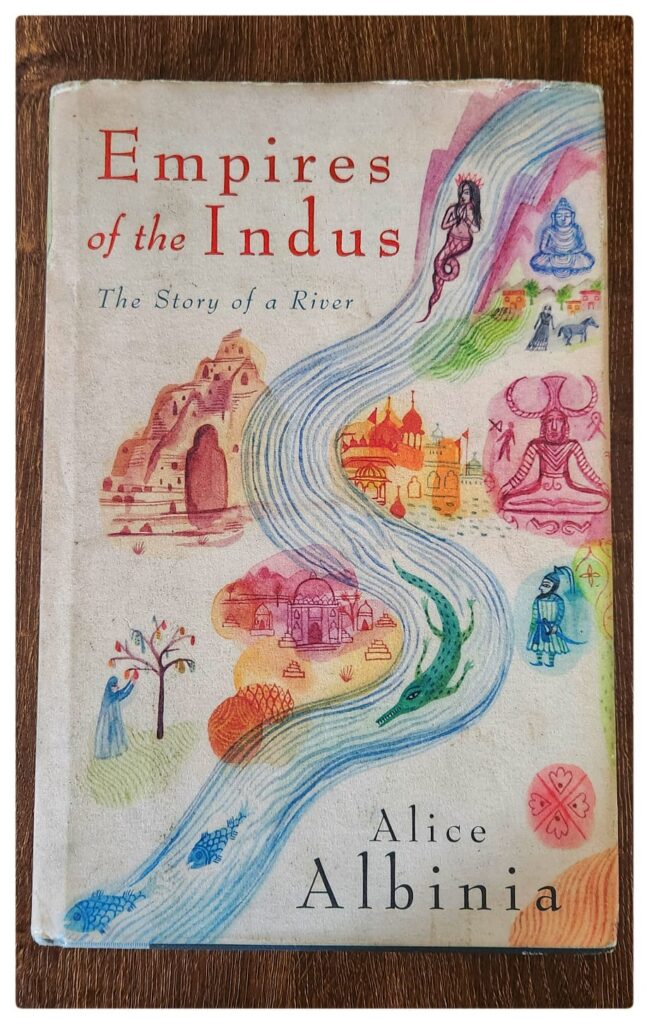
In Empires of the Indus- The Story of a River, Alice Albinia explores the regions around the Indus from its end point in the Arabian sea near Karachi to its source high in the Tibetan plateau. She criss-crosses across countries, sometimes on foot, at times through illegal border crossings, trekking with outlanders exploring the diversity and culture of the region through which the Indus passes. Travelling across Afghanistan, Pakistan, India and Tibet through which the tributaries flow she finds a river ravaged by the land, its rulers and passing of time.
In the opening passages of her encounters with the natives, she gives the impression of condescension toward the culture, values, and society of those she meets, often while staying as a guest. I could be mistaken in my interpretation.
She speaks with a sense of tragedy on the current state of the Indus as it is violated and dammed by the rulers who govern the waters only to benefit people living in urbanised cities with people living off it having no say in its preservation.
She celebrates Ramzan in Karachi and spends time in Sindh where the Indus is called “Purali” for its impulsive and unpredictable behaviour.
Alice Albinia delves deeper than just environmental concerns; she dives into the historical tapestry of the subcontinent. Her narrative weaves together the stories of Kings and Emperors who undertook epic voyages to reach these shores.
She briefly touches upon the remarkable evolution of the blind dolphin, a species that adapted and survived through ages without the gift of sight. And through her words, we traverse the annals of history, encountering the likes of Alexander the Great, the valiant Poros, the visionary Ashoka, and the opulent Mughals.
Albinia takes us on a journey that unravels the origins of Sikhism, traces the propagation of Buddhist teachings, and sheds light on their enduring influence in far-flung lands like Afghanistan where the Bamiyan Buddha once stood.
She tells us how it was Chandragupta Maurya “who accomplished what Alexander had failed to do and united an empire.”, and how Alexander and Poros go on to become allies forging an alliance making Poros his regent.
The segments that captured my attention most were the aspects which covered the origins of the Aryan race and the discovery of the Harappan and Mohen jo Daro ruins which lead to sharply dividing theories among ideologies who lay claim to these histories.
I take a moment to reflect on the sophistication in design and layout of these cities, something which has not been accomplished in the modern metropolises of the subcontinent even today. The ruins at the banks of the Indus probably were the world’s first planned cities, built five millennia ago. They didn’t make castles or forts but drains, sewage systems, flood defences, public baths and granaries for people who live there. Not monuments or statues celebrating kings or tyrants.
Nevertheless she reaches the pinnacle of her voyage triumphing over freezing weather and challenging mountain trails along the Indus by travelling to its source- the Senge Khabab or the Lion’s Mouth, its Tibetan name.
She takes copious notes of every detail worth taking along her journey coming across motifs and eight-thousand-year-old rock carvings standing on boulders and cliffs overlooking the Indus. Walking on foot along the same route taken by Alexander the Great and his army from Afghanistan to Pirsar.
Alice Albinia traverses a broad spectrum of historical events, ranging from the initial human migration from Africa, through the challenging division of the subcontinent, up to the interplay of contemporary politics where ideologies strive to rewrite and reinterpret history.
Her words leave a lasting impact- “If a dam is the supreme symbol of man’s attempt to control nature, the nomads of the Tibetan plateau are exemplars of harmony.”
Empires of the Indus- A Story of a River is a must read if you have any interest in the history of the subcontinent, the origins of its people and of Kings and Empires.

Leave a Reply